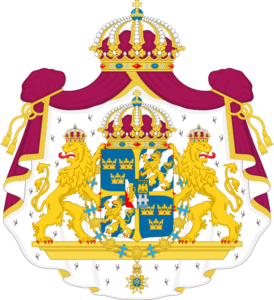orders of chivalry
kingdom of sweden
Brief history of sweden
From around 8,000 BCE, Sweden’s first humans settled the land. Sweden’s history that began with prehistoric hunting camps in the southernmost part of the country. From 8,000 BC to 6,000 BC, Sweden was populated by people who lived by hunting, gathering, and fishing.
Viking age 800-1050 AD
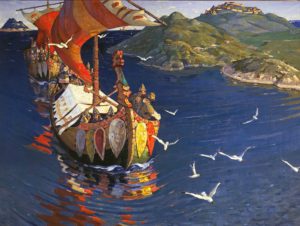
traditional viking ships
Viking Age Begins with the end of Swedish prehistory. The Viking Age in Sweden was characterized by a significant expansion of activity, toward the east. Many Viking expeditions set off from Sweden to both plunder and trade along the Baltic coast and the rivers that stretched deep into present-day Russia. The Vikings traveled as far as the Black and Caspian Seas, where they developed trading links with the Byzantine Empire and the Arab kingdoms.
introduction of christianity to the vasa period
Introduction to Christianity 830 AD
The first attempt to Christianize Sweden was made by the Frankish monk Ansgar in 830, he set up a church and was permitted to preach, but the country was not converted to Christianity until the 11th century.
Consolidation of Power 1000 AD
The various provinces of Sweden were absorbed around 1000 AD into a single unit, but the crown began to gain significant influence only during the late 13th century. In 1280 King Magnus Ladulås issued a statute authorizing the establishment of a nobility and the organization of society based on the feudal model.
The Kalmar Union and Swedish Independence
In 1389, the crowns of Denmark, Norway and Sweden were united under the rule of the Danish Queen Margareta. In 1397, the Kalmar Union was formed, with the three Scandinavian countries under a single monarch. However, the union (1397–1523) was scarred by internal conflicts that culminated in the ‘Stockholm Bloodbath’ in 1520, when 80 Swedish nobles were executed at the instigation of the Danish union king, Kristian II. The act provoked a rebellion, which in 1521 led to the deposition of Kristian II and the seizure of power by a Swedish nobleman, Gustav Vasa, who was elected king of Sweden in 1523.
The Vasa period
The foundations of the Swedish state were laid during the reign of Gustav Vasa (1523–60). The church was nationalized, its estates confiscated by the crown, and the Protestant Reformation was introduced. Power was concentrated in the hands of the king and hereditary monarchy came into force in 1544.
the swedish empire
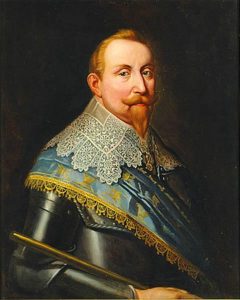
King Gustaf II Adolf
Since the dissolution of the Kalmar Union, Swedish foreign policy was aimed at gaining dominion over the Baltic Sea, leading to repeated wars with Denmark from the 1560s onward. After Sweden successful intervention in 1630 on behalf of German Protestants during the Thirty Years’ War, King Gustav II Adolf became one of Europe’s most powerful monarchs. By 1658, Sweden controlled a large area which included parts of present-day Germany, the Baltic states, Finland, as well as several provinces in Denmark. In 1700, Russia, Saxony-Poland, and Denmark-Norway defeated Sweden in what came to be known as the “Great Northern War”. This defeat ended Sweden’s status as a great European Power.
modern sweden
During the Napoleonic wars, Sweden was forced to cede Finland to Russia in 1809. In 1813 however, Sweden fought against Napoleon and shortly thereafter the Congress of Vienna created a merger between Sweden and Norway in a dual monarchy (this union was later dissolved peacefully in 1905).
Throughout the rest of the 1800s, Sweden’s economy shifted to private agriculture and as a result, its economy suffered. Between 1850 and 1890, about a million Swedes emigrated to the United States. During World War I and World War II, Sweden remained neutral and was able to benefit by producing products like steel, ball bearings, and iron ore. After the wars, its economy improved, and the country began to develop the social welfare policies that it has today. Sweden joined the European Union in 1995.
Monarchy
Sweden is a constitutional monarchy, and King Carl XVI Gustaf is the head of state, but the role of the monarch is limited to ceremonial and representative functions. Under the provisions of the 1974 Instrument of Government, the King lacks any formal political power. The King opens the annual Riksdag session, chairs the Special Council held during a change of Government, holds regular Information Councils with the Prime Minister and the Government, chairs the meetings of the Advisory Council on Foreign Affairs, and receives Letters of Credence of foreign ambassadors to Sweden and signs those of Swedish ambassadors sent abroad. In addition, the King pays State Visits abroad and receives those incoming as host. Apart from strictly official duties, the King and the other members of Royal Family undertake a variety of unofficial and other representative duties within Sweden and abroad.
king of sweden
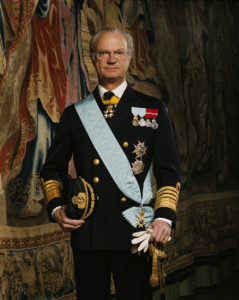
his majesty carl xvi gustaf
His Majesty Carl XVI Gustaf, born April 30, 1946, has been king of Sweden since 1973. He is the longest-reigning monarch in Swedish history, having surpassed King Magnus IV’s reign of 44 years and 222 days on 26 April 2018
The only son of King Gustav VI Adolf’s eldest son, Prince Gustav Adolf (who died in an air crash in 1947), His Majesty became crown prince in 1950, when his grandfather acceded to the throne. He studied at military cadet schools, University of Uppsala as well as the University of Stockholm. He was commissioned as a naval officer in 1968. He married Silvia Sommerlath in 1976, three years after his accession. The royal couple had three children, Crown Princess Victoria, Prince Carl Philip, and Princess Madeleine.
In addition to an interest in art, music, and food, His Majesty appreciates outdoor life, different sports activities plus hunting and wildlife.
His Majesty is the Patron to many worthwhile foundations, two notable organizations are The Swedish Guide and Scout Association and the Swedish Guide and Scout Council and the The World Scout Foundation. A complete list of the organizations His Majesty is the Patron of can be found at https://www.kungahuset.se/royalcourt/royalfamily/hmkingcarlxvigustaf/patronage.4.79674e441551060720020.html
prime minister of sweden
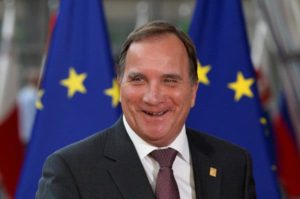
prime minister Stefan Löfven
Stefan Löfven is the incumbent and 33rd Prime Minister of Sweden. He assumed office on 3 October 2014 as the successor of Frederik Reinfeldt. Löfven is also the Leader of the Social Democrats Party since 27 January 2012. From 2006 to 2012, Löfven held the office of Chairman of IF Metall.
Prime Minister Löfven enjoys sports and supports the ice hockey club Modo from Örnsköldsvik and the football clubs Tottenham Hotspur and GIF Sundsvall. He is married to politician and trade unionist Ulla Löfven and has 2 stepchildren.
pippi longstocking

Perhaps one of the most famous Swedes is the fictional character Pippi Longstocking, created by Astrid Lindgren. Her father is Captain Efraim Longstocking. Pippilotta Delicatessa Windowshade Mackrelmint Longstocking, the strongest girl in the world, is the nine-year-old daughter of sea-captain Efraim Longstocking.
The freckle-faced girl with the iconic red hair, together with her Monkey, Mr. Nilsson, her horse, and her two neighbors Tommy and Annika, have had their unusual adventures captured in three books, as well as several movies and television series since 1948. The Pippi Longstocking books have been published in over 70 languages since they were released.
swedish culture
Sweden is one of the most egalitarian societies in the world. One of the most notable aspects of Swedish culture is their respect for the environment and commitment to sustainability. They are a global leader in organic agriculture, recycling, and renewable energy.
Most of the population lives in small rural towns, and while the major cities are populous and modern, many still have some medieval architecture and cobblestone streets, where you’ll see Swedes hanging out and shopping for groceries at local markets.
Swedish society is based on equality and individualism. Swedes are proud of their nation and its accomplishments. Lagom, which means “not too much, not too little…just right” is a word often used and heard in Sweden. Swedes also have a profound respect for integrity. Although they may appear to be reserved and shy at first, they have a great sense of humor and caring
food

Traditional swedish meatballs
The most common meal in Swedish families consists of fish or meat and potatoes, rice or pasta. You will also quickly learn the concept of “fika.” That is coffee/drinks with cookies or often “kanelbulle”, a bun with cinnamon. Typical traditional Swedish food include for meatballs, herring and Smörgåsbord (buffét). Vegetarianism is becoming more popular in Sweden and you can get vegetarian food in almost every restaurants. School food is often influenced by other cultures, although changed to suit a Swedish context.
In Sweden people like to eat hearty home-style cooking. Typical traditional Swedish food includes meatballs (Köttbullar), fish, and usually herring, potatoes. Rice, pasta, reindeer, and elk are also common dishes. Swedes love sweets, and they are a very common part of the cuisine.
Breakfast is called Frukost in Sweden. Bread or rolls with cheese and sausage is a typical breakfast of this type. There is also juice, milk, tea or, for the adults, coffee. Filmjölk, a sour sour milk, is also enjoyed. It is often mixed with oatmeal, berries, jam, or cinnamon and sugar. Oatmeal porridge with milk is called Havregrynsgröt.
Lunch, served at noon, is widely considered the main meal of the day. It is usually consists of a warm meal. Frestelse, a potato casserole, or köttbullar, which are eaten with cranberry compote, sauce, and boiled potatoes or mashed potatoes, are popular.
Dinner is called Middag or Kvällsmat. It is usually a light warm meal or bread.
The most typical pastry in Sweden is probably the cinnamon bun, the Kanelbulle. Several of them are then called Kanelbullar. On October 4th Swedes celebrate the day of the cinnamon bun. But even more sweet things you like to eat like, for example Semlor, princess cake, Chokladbollar and Spettekaka.
At parties, the Smörgåsbord, a cold buffet, is served. The word translated means “bread and butter table”. During Christmas time, the buffet is then called Julbord; translated as “Christmas table”
Swedish royal orders
The Orders, decorations, and medals of Sweden have a historical basis with the founding of the extinct Order of Jehova Order. The Order of was a Swedish dynastic order of knighthood instituted in 1606 by King Charles IX of Sweden.
Royal Order of Knights of Sweden were not codified until the 18th century, when in 1748, Frederick I of Sweden instituted the Orders of the Seraphim, Sword, and Polar Star. In 1772 King Gustav III instituted of the Order of Vasa. Today, only the Order of the Seraphim and the Order of the Polar star ate the only royal orders awarded.
The King is “Lord and Master”, or “Grand Master”, of all Swedish orders, with the exception of the Order of the Seraphim, The Swedish orders were awarded in five degrees. The degrees were Commander Grand Cross, Commander First Class, Commander, Officer First Class and Officer. Women and clergy are called “members”, not “officers”, of the awarded orders.
Under a law passed in 1974, Swedish orders can only be conferred on foreign citizens or stateless persons for personal services to Sweden or Swedish interests. In 1995, the Monarch was given the ability confer the Order of the Seraphim and degrees in the Order of the Polar Star to members of the Swedish Royal Family.
The Order of the Seraphim
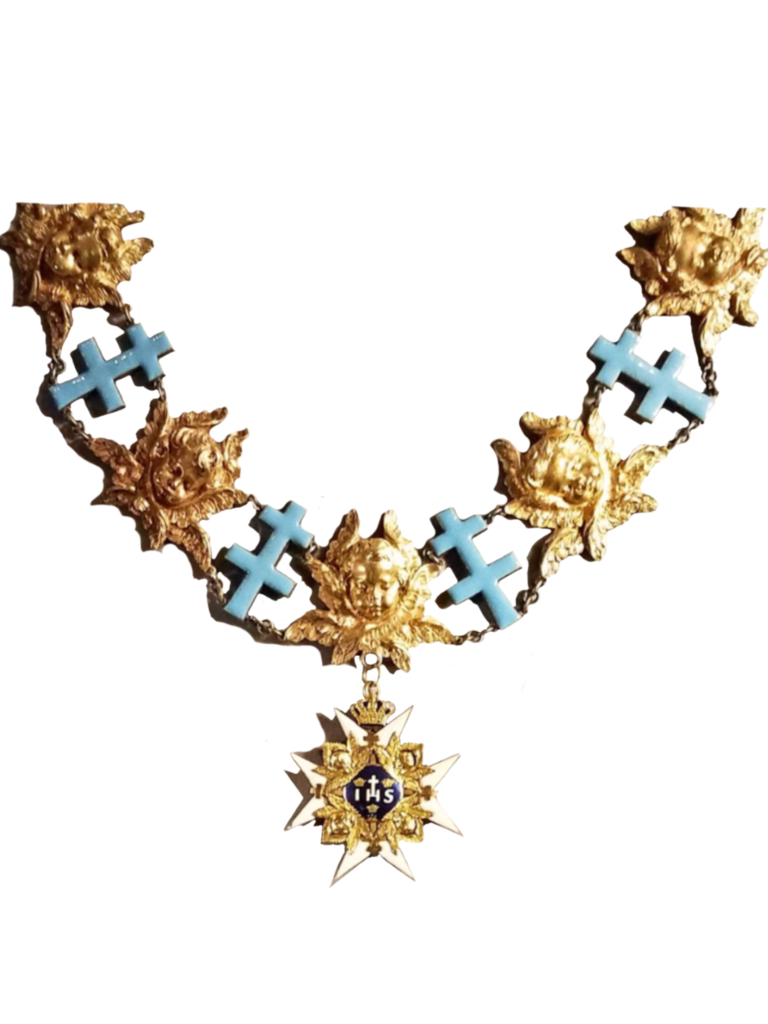
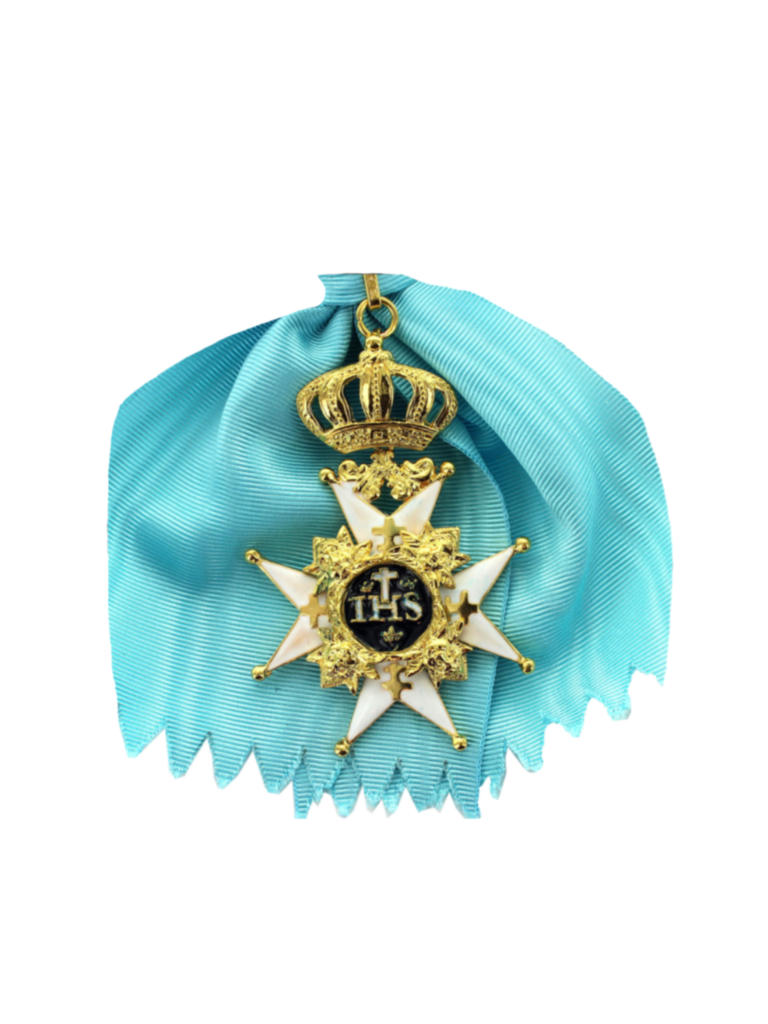
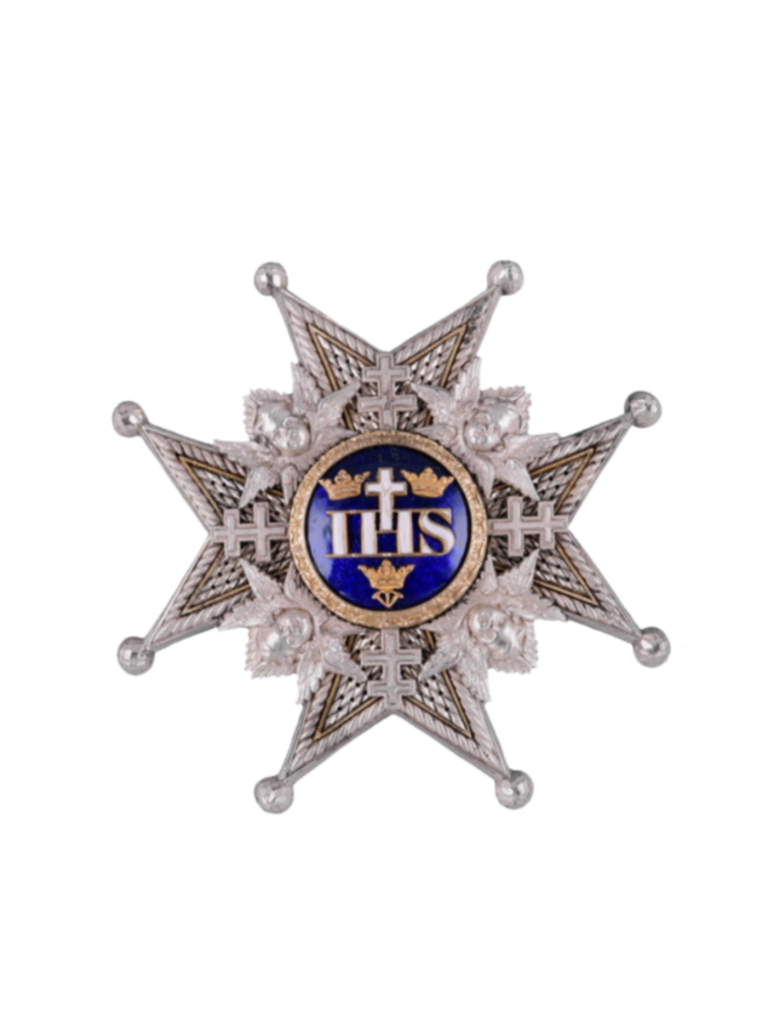
The Order of the Seraphim is the highest distinction awarded in Sweden. Today, it is conferred exclusively on members of the Swedish Royal Family and on foreign heads of state or other persons of comparable rank. The Order has only one Class with the dignity of Knight or Member.
The insignia
The insignia of the Order are the Collar, Badge and Grand Star. The Collar of the Order is only bestowed as a mark of special distinction. The Collar of the Order of the Seraphim consists of eleven gold seraphims, alternating with eleven blue patriarchal crosses, set in gold, joined with gold links.
The Badge
The Badge consists of a white Maltese cross set in gold, in the center of which is a blue medallion bearing the monogram of Christ “IHS” (Jesus Hominum Salvator – Jesus the Saviour of Mankind). The Badge is surmounted by a golden Royal crown, by which it is fastened to the collar or to a light blue moiré ribbon.
History
The Order of the Seraphim was instituted by King Fredrik I in 1748. The initials FRS (Fredericus Rex Sueciae), in are engraved on the reverse of the medallion.
The coat of arms in Riddarholmen Church
A Knight or Member should submit proposals regarding his Seraphim arms and a motto to the armorial painter to the Royal Orders.
On the death of a Knight or Member of the Order, his or her coat of arms, designed in accordance with the above, will be mounted in Riddarholmen Church on the occasion of the funeral of the deceased Knight or Member.
The bells are tolled at Riddarholmen Church on the occasion of the funeral of a deceased Knight or Member.
order of the polar star
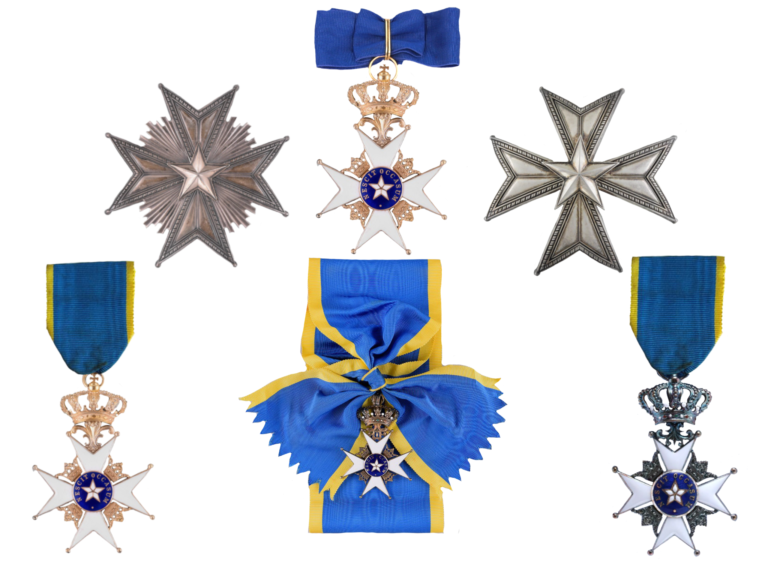
The Order of the Polar Star was until 1975 intended as a reward for Swedish and foreign “civic merits, for devotion to duty, for science, literary, learned and useful works and for new and beneficial institutions”.
The cross of the order is of the Maltese type and was originally worn in a black sash; since 1975 the sash is blue with yellow edges. The emblem bears the device of the order, “Nescit occasum” (It knows no decline.)
The Order has five degrees:
Commander Grand Cross (KmstkNO) – Wears the badge on a collar (chain) or on a sash over the right shoulder, plus the star on the left chest;
Commander 1st Class (KNO1kl) – Wears the badge on a necklet, plus the star on the left chest;
Commander (KNO) – Wears the badge on a necklet;
Knight 1st Class (RNO1kl/LNO1) – Wears the badge on a ribbon on the left chest;
Knight (RNO/LNO) – Wears the badge on a ribbon on the left chest.
This order also has a medal, “the Polar Star Medal”. As of 1975, the Order of the Polar Star is presented to foreign nationals or stateless persons.
other honors
Apart from the national, official system of orders, Sweden, like most other countries, has a number of official and quasi-official orders, foremost among them being the Order of King Carl XIII, of which The King is Grand Master. The quasi-official orders include the Order of St John in Sweden.
Other recognized orders are the Grand Order of the Amaranth, instituted by Queen Kristina in 1653, and the Order of Innocence, both of which are to be regarded as fraternities/sororities or “social orders”.
This section was produced with permission of the Office of the Royal Court of Sweden. Sweden is a stunning country made up of thousands of islands, beautiful lakes, dense forests, and snow-capped mountains. It is a nation of unparalleled natural beauty which boasts longstanding cultural traditions and a long and interesting history. Whether visiting the capital of Stockholm or the medieval town of Sigtuna, there is so much in Sweden to see, experience, and eat. For more information on Sweden, visit the official tourism website at www.visitsweden.com
